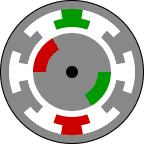How it works |
||
|
The first things that come to mind when thinking of an electric snowmobile are:
These components are definitely essential to an electrical snowmobile. However, there is much more to it than just connecting some batteries to a motor in order to get the snowmobile running. Other components such as a controller, a precharge circuit, protective circuitry, and electronic controls must also be added to the system. This section will walk you through the "how's" and "why's" of the electrical aspect of the snowmobile. First, there are many different types of electric motors separated into two categories. The categories are based on the power source: AC Motors
DC Motors
DC (direct current) and AC (alternating current) are very different. Direct current electricity refers to the direct flow of electrons in a conductor (wire). A battery is a typical DC source. Alternating current electricity refers to the "back and forth" movement of electrons. An alternating current is established by reversing the flow of electrons every so often. For example here in North America , the current is reversed 60 times per second. AC electricity is what powers your lights at home (for example). Our team uses a 14" e-TORQ DC Brushless motor donated by Bodine Electric . The name "DC Brushless motor" is somewhat deceiving though. You cannot simply connect DC batteries directly to our e-TORQ motor because the motor itself requires a 3-Phase AC signal (i.e. 3 AC signals that are out of phase from each other). This is where the NGM-EVC200 motor controller comes in. Among its many features, its main purpose is to convert a DC signal (from the batteries) into the required 3-phase AC signal. So why not just go with a regular DC motor and save the money and complications of a controller and DC brushless motor? A DC brushless motor offers greater reliability (no brushes), quieter operation since there is no friction from brushes, low maintenance (brushes require maintenance), superior heat transfer (again no friction caused by brushes) and a very high torque output. These are all features beneficial to the snowmobile. |
|
| The following graphic gives a simplified look at the inside of a DC Brushless motor. The permanent magnets at the center of the graphic are attached to a rotor . The rotor is surrounded by a stator with windings. | ||
The animation shows how a DC brushless motor turns. The windings (6 in this example) are energized in a pattern that rotates around the rotor. The energized windings lead the rotor magnets so that these magnets are forced to catch up with the windings. That is, by magnetic forces, the permanent magnets are attracted to the energized winding. Once the permanent magnets are aligned with the energized winding, the next winding in the circle is energized which causes the rotor to rotate towards it, providing motion. The NGM-EVC200 motor controller energizes the windings in the proper order and the correct speed to ensure a smooth rotation of the drive shaft.
|
Animation © Motorola Inc. |
|
